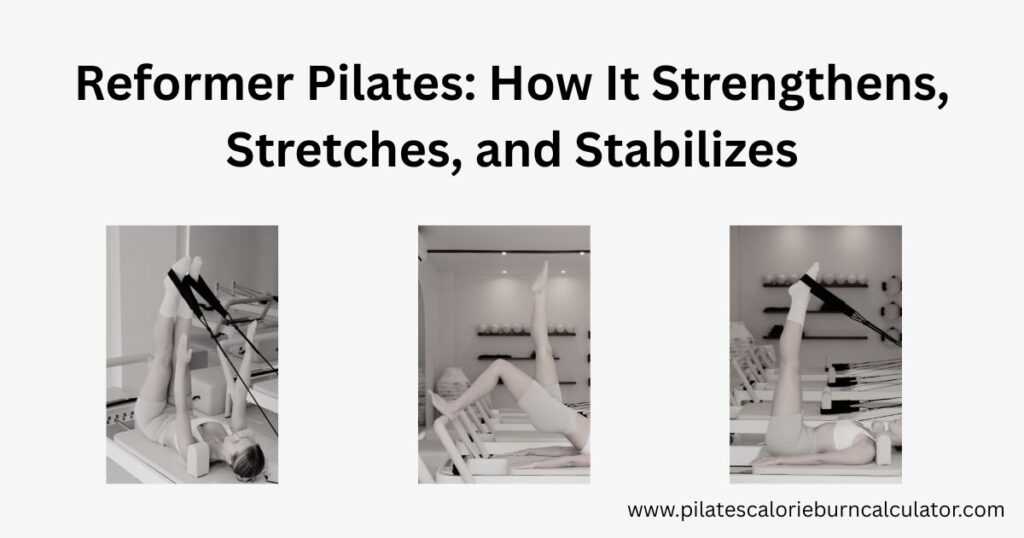
Reformer Pilates has gained a strong reputation for its ability to tone muscles, improve posture, and promote total body wellness. But behind the graceful movements and spring-loaded machines lies a powerful foundation in biomechanics and muscle activation science.
In this post, we’ll dive into how Reformer Pilates strengthens, stretches, and stabilizes the body — and why it’s far more than just a trendy fitness class.
What Is Reformer Pilates?
Unlike mat Pilates, the Reformer adds dynamic resistance, which means it challenges not only strength and flexibility, but also neuromuscular control — your brain’s ability to recruit the right muscles at the right time.
How Reformer Pilates Strengthens Your Body
1. Controlled Resistance for Functional Strength
The Reformer’s adjustable springs provide constant, low-impact resistance, engaging both concentric (shortening) and eccentric (lengthening) muscle contractions.
Example: In leg presses, you push the carriage away (concentric quads) and then control the return (eccentric quads), building functional strength that’s highly transferable to daily activities.
2. Core Activation with Every Move
The transversus abdominis, multifidus, pelvic floor, and diaphragm — collectively known as the deep core or inner unit — are engaged throughout most Reformer exercises.
This helps build true core stability, not just surface-level abs, which supports spinal alignment and reduces risk of injury.
3. Total-Body Engagement
Reformer movements often require coordination between the upper and lower body.
Example: A movement like “Long Stretch” recruits shoulders, chest, abs, glutes, and hamstrings in one smooth, controlled motion.
How It Stretches Your Muscles
1. Active and Dynamic Stretching
Unlike static stretching, Reformer Pilates promotes active range-of-motion stretches that maintain muscle tension during lengthening phases.
This keeps muscles warm and responsive, promoting real-world flexibility that’s usable under load and in motion.
2. Targeted Muscle Lengthening
Movements like feet-in-straps leg circles stretch the hip flexors, hamstrings, and adductors, while requiring core control and pelvic stability.
This combo prevents overstretching while balancing mobility with control — a key principle in functional biomechanics.
3. Fascial Release
The slow, rhythmic movements encourage myofascial release, helping reduce stiffness in connective tissues and promoting improved circulation and elasticity.
How It Stabilizes the Body
1. Enhances Proprioception
Pilates requires you to maintain control in unstable positions — think one-legged footwork or single-arm pulling — which sharpens your body’s proprioception (spatial awareness).
This strengthens the smaller, stabilizing muscles, like the gluteus medius, serratus anterior, and rotator cuff muscles, which are often underused in conventional training.
2. Promotes Spinal Alignment and Postural Strength
Many exercises involve spinal articulation — like bridging or spinal flexion/extension — helping to improve posture and spinal health.
By strengthening the muscles along the spine (erector spinae, multifidus), Reformer Pilates supports long-term postural correction and alignment.
3. Improves Joint Stability
Thanks to spring resistance and low-impact movement, Reformer Pilates strengthens muscles around critical joints like the knees, hips, and shoulders without overloading them.
This is especially beneficial for injury prevention and rehabilitation.
Reformer Pilates & the Mind-Muscle Connection
One of the most overlooked aspects of Reformer Pilates is its neural demand. Every movement is performed with intention. You’re not zoning out — you’re tuning in.
This deepens the mind-muscle connection, activating motor units more efficiently and improving neuromuscular coordination over time.
The result? More efficient movements, improved posture, and reduced risk of injury, whether you’re an athlete or just navigating daily life.
Summary: The Science in Motion
| Function | How Reformer Pilates Helps |
|---|---|
| Strength | Builds full-body functional strength with eccentric control |
| Flexibility | Promotes active, controlled stretching |
| Stability | Improves joint health, balance, and postural control |
| Neural Control | Enhances coordination and body awareness |
Conclusion:
Reformer Pilates isn’t just elegant movement on a machine — it’s a science-backed method that enhances your body’s strength, flexibility, and stability in a smart, sustainable way.
Whether you’re recovering from injury, building a foundation of strength, or leveling up your athletic performance, the Reformer delivers measurable results — with less strain on your joints and more engagement in every muscle fiber.